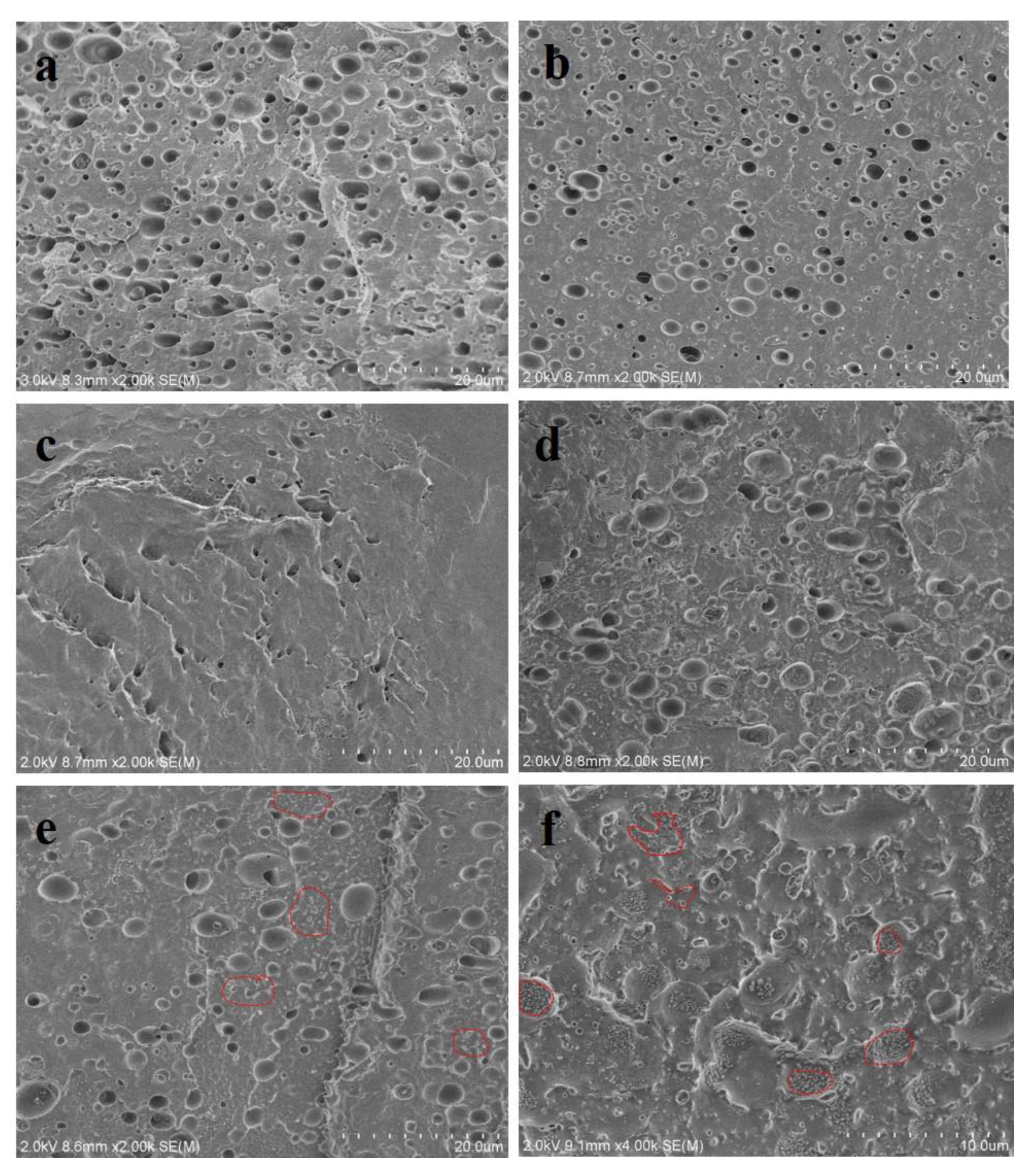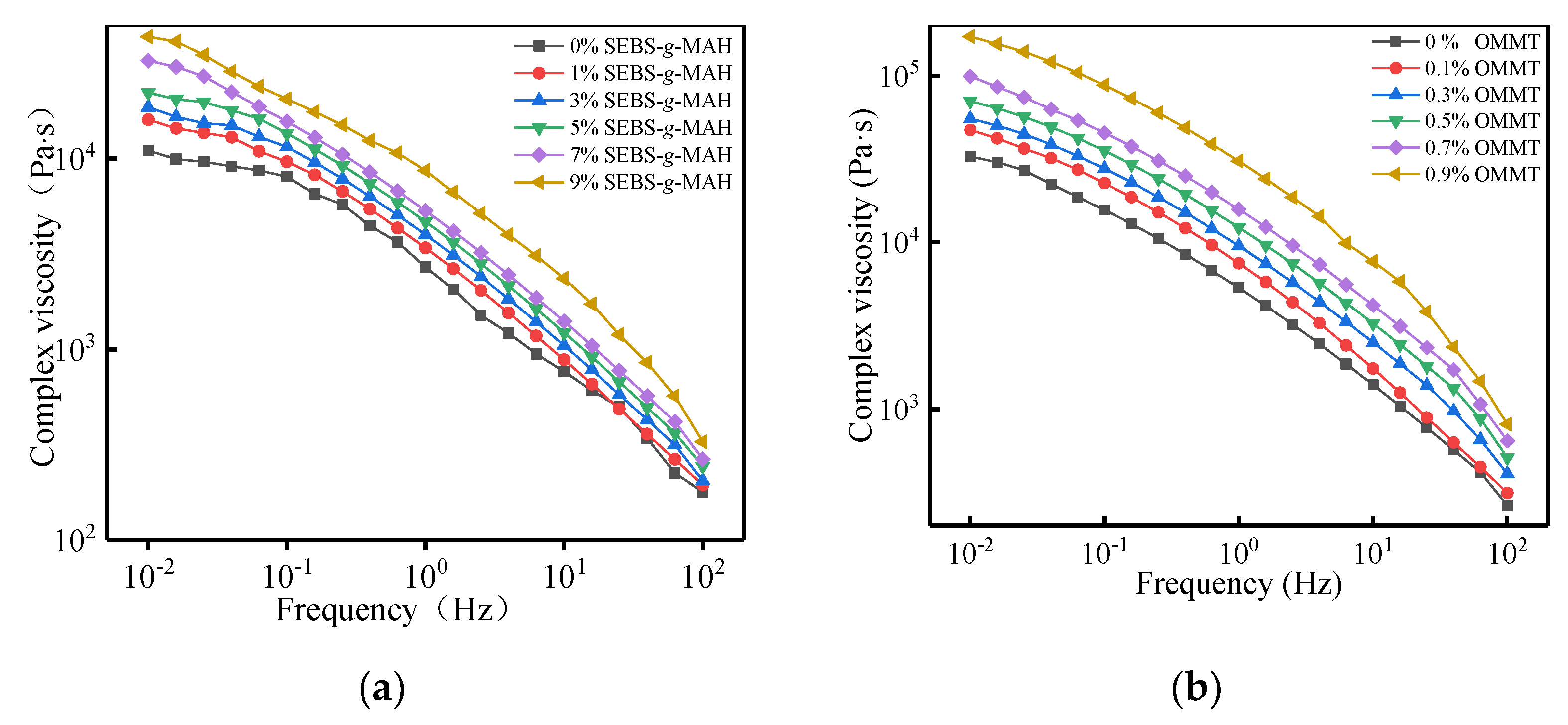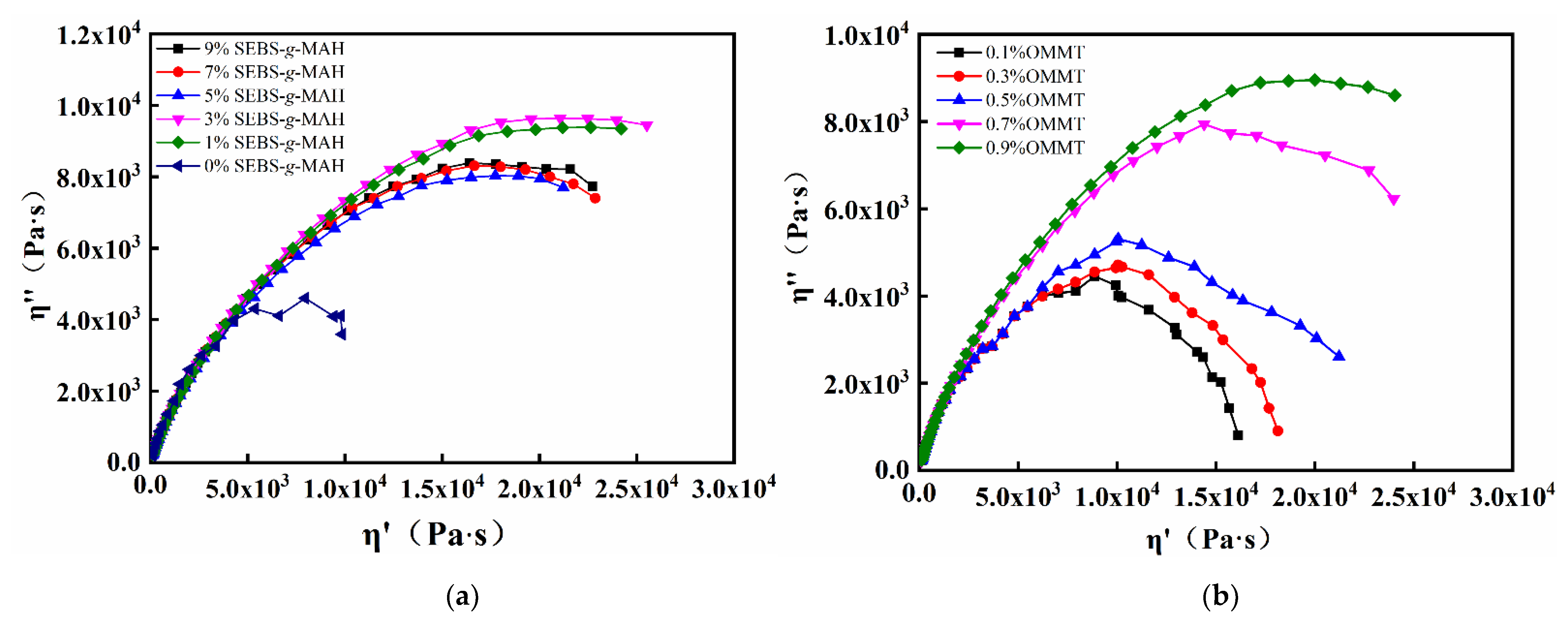Finely Modulated LDPE/PS Blends via Synergistic Compatibilization with SEBS-g-MAH and OMMT
Abstract
:1. Introduction
2. Materials and Methods
2.1. Materials
2.2. Sample Preparation
2.3. Characterization
2.3.1. Morphology
2.3.2. X-ray Diffraction (XRD) Analysis
2.3.3. Rheological Property Analysis
2.3.4. Mechanical Tests
3. Results and Discussion
3.1. Morphology
3.2. X-ray Diffraction Analysis of Composite
3.3. Rheological Behavior of Composite
3.4. Cole–Cole Plot Analysis of Composite
3.5. Mechanical Properties
4. Conclusions
Author Contributions
Funding
Institutional Review Board Statement
Informed Consent Statement
Data Availability Statement
Conflicts of Interest
References
- Yang, L.-Y.; Smith, T.G.; Bigio, D. Melt blending of linear low-density polyethylene and polystyrene in a haake internal mixer. I. Compatibilization and morphology development. J. Appl. Polym. Sci. 1995, 58, 117–127. [Google Scholar] [CrossRef]
- Wu, B.; Yang, Y.; Li, M.; Zhu, K.; Iqbal, Z.; Li, Y. Enhanced thermal conductivity of polyamide-66 composites with mesocarbon microbeads through simple melt blending. Polym. Eng. Sci. 2022, 62, 530–536. [Google Scholar] [CrossRef]
- Enrique-Jimenez, P.; Quiles-Díaz, S.; Salavagione, H.J.; Fernández-Blázquez, J.P.; Monclús, M.A.; Guzman de Villoria, R.; Gómez-Fatou, M.A.; Ania, F.; Flores, A. Nanoindentation mapping of multiscale composites of graphene-reinforced polypropylene and carbon fibres. Compos. Sci. Technol. 2019, 169, 151–157. [Google Scholar] [CrossRef]
- Tabasum, S.; Younas, M.; Zaeem, M.A.; Majeed, I.; Majeed, M.; Noreen, A.; Iqbal, M.N.; Zia, K.M. A review on blending of corn starch with natural and synthetic polymers, and inorganic nanoparticles with mathematical modeling. Int. J. Biol. Macromol. 2019, 122, 969–996. [Google Scholar] [CrossRef]
- Masudur Rahman, A.N.M.; Alimuzzaman, S.; Khan, R.A.; Hossen, J. Evaluating the performance of gamma irradiated okra fiber reinforced polypropylene (PP) composites: Comparative study with jute/PP. Fash. Text. 2018, 5, 28. [Google Scholar] [CrossRef] [Green Version]
- Mariello, M.; Guido, F.; Mastronardi, V.M.; De Donato, F.; Salbini, M.; Brunetti, V.; Qualtieri, A.; Rizzi, F.; De Vittorio, M. Captive-air-bubble aerophobicity measurements of antibiofouling coatings for underwater MEMS devices. Nanomater. Nanotechnol. 2019, 9, 1847980419862075. [Google Scholar] [CrossRef] [Green Version]
- Liao, H.-Y.; Lu, H.-B. Rheological behavior of a LDPE/PS/SBS blending melt. Polym. Bull. 2014, 71, 3237–3247. [Google Scholar] [CrossRef]
- Van Eerdenbrugh, B.; Taylor, L.S. Molecular Weight Effects on the Miscibility Behavior of Dextran and Maltodextrin with Poly(vinylpyrrolidone). Pharm. Res. 2012, 29, 2754–2765. [Google Scholar] [CrossRef]
- Wang, D.; Li, Y.; Xie, X.-M.; Guo, B.-H. Compatibilization and morphology development of immiscible ternary polymer blends. Polymer 2011, 52, 191–200. [Google Scholar] [CrossRef]
- Sperling, L.H.; Howard, L. Introduction to Physical Polymer Science; John Wiley & Sons, Inc.: Hoboken, NJ, USA, 1986. [Google Scholar]
- Zhu, N.; Ye, M.; Shi, D.; Chen, M. Reactive compatibilization of biodegradable poly(butylene succinate)/Spirulina microalgae composites. Macromol. Res. 2017, 25, 165–171. [Google Scholar] [CrossRef]
- Li, R.; Yu, W.; Zhou, C. Phase Behavior and its Viscoelastic Responses of Poly(methyl methacrylate) and Poly(styrene-co-maleic anhydride) Blend Systems. Polym. Bull. 2006, 56, 455–466. [Google Scholar] [CrossRef]
- Afzali, M.; Morshedian, J.; Moballegh, L.; Ahmadi, S. Comparing effects of two tri-block copolymers on morphology, thermal, mechanical and rheological properties of polystyrene/low density polyethylene blends. Mater. Res. Express 2018, 5, 085305. [Google Scholar] [CrossRef]
- Dobrovszky, K.; Ronkay, F. Investigation of compatibilization effects of SEBS-g-MA on polystyrene/polyethylene blend with a novel separation method in melted state. Polym. Bull. 2016, 73, 2719–2739. [Google Scholar] [CrossRef] [Green Version]
- Rek, V.; Vranješ, N.; Šlouf, M.; Fortelný, I.; Jelčić, Ž. Morphology and Properties of SEBS Block Copolymer Compatibilized PS/HDPE Blends. J. Elastomers Plast. 2008, 40, 237–251. [Google Scholar] [CrossRef]
- Yang, L.-Y.; Bigio, D.; Smith, T.G. Melt blending of linear low-density polyethylene and polystyrene in a Haake internal mixer. II. Morphology-processing relationships. J. Appl. Polym. Sci. 1995, 58, 129–141. [Google Scholar] [CrossRef]
- Díaz, M.F.; Barbosa, S.E.; Capiati, N.J. Reactive compatibilization of PE/PS blends. Effect of copolymer chain length on interfacial adhesion and mechanical behavior. Polymer 2007, 48, 1058–1065. [Google Scholar] [CrossRef]
- Xing, Z.; Wang, M.; Du, G.; Xiao, T.; Liu, W.; Qiang, D.; Wu, G. Preparation of microcellular polystyrene/polyethylene alloy foams by supercritical CO2 foaming and analysis by X-ray microtomography. J. Supercrit. Fluids 2013, 82, 50–55. [Google Scholar] [CrossRef]
- Zhang, G.; Wang, Y.; Xing, H.; Qiu, J.; Gong, J.; Yao, K.; Tan, H.; Jiang, Z.; Tang, T. Interplay between the composition of LLDPE/PS blends and their compatibilization with polyethylene-graft-polystyrene in the foaming behaviour. RSC Adv. 2015, 5, 27181–27189. [Google Scholar] [CrossRef]
- Zhang, S.; Zhang, G.; Qiu, J.; Jiang, Z.; Xing, H.; Li, M.; Tang, T. The effect of nanosized carbon black on the morphology and sc-CO2 foaming behavior of LLDPE/PS blends at semi-solid state. Compos. Commun. 2018, 7, 30–35. [Google Scholar] [CrossRef]
- Shi, Z.; Zhang, S.; Qiu, J.; Li, M.; Xing, H.; Tang, T. Striking effect of carbon nanotubes on adjusting sc-CO2 foaming performance of PS/LLDPE blends and forming semi-open cellular structure. Polymer 2020, 207, 122896. [Google Scholar] [CrossRef]
- Ray, S.S.; Pouliot, S.; Bousmina, M.; Utracki, L.A. Role of organically modified layered silicate as an active interfacial modifier in immiscible polystyrene/polypropylene blends. Polymer 2004, 45, 8403–8413. [Google Scholar] [CrossRef] [Green Version]
- Zhang, Q.; Yang, H.; Fu, Q. Kinetics-controlled compatibilization of immiscible polypropylene/polystyrene blends using nano-SiO2 particles. Polymer 2004, 45, 1913–1922. [Google Scholar] [CrossRef]
- Horák, Z.; Hlavatá, D.; Fortelný, I.; Lednický, F. Effect of styrene-butadiene triblock copolymer structure on its compatibilization efficiency in PS/PB and PS/PP blends. Polym. Eng. Sci. 2002, 42, 2042–2047. [Google Scholar] [CrossRef]
- Zhang, G.; Zhang, S.; Qiu, J.; Jiang, Z.; Xing, H.; Li, M.; Tang, T. Insight into the influence of OA-Fe3O4 nanoparticles on the morphology and scCO2 batch-foaming behavior of cocontinuous LLDPE/PS immiscible blends at semi-solid state. Polymer 2017, 129, 169–178. [Google Scholar] [CrossRef]
- Ma, P.; Cai, X.; Zhang, Y.; Wang, S.; Dong, W.; Chen, M.; Lemstra, P.J. In-Situ compatibilization of poly(lactic acid) and poly(butylene adipate-co-terephthalate) blends by using dicumyl peroxide as a free-radical initiator. Polym. Degrad. Stab. 2014, 102, 145–151. [Google Scholar] [CrossRef]
- Li, Y.-Y.; Hu, S.-W.; Sheng, J. Evolution of phase dimensions and interfacial morphology of polypropylene/polystyrene compatibilized blends during mixing. Eur. Polym. J. 2007, 43, 561–572. [Google Scholar] [CrossRef]
- Shahbazi, K.; Razavi Aghjeh, M.K.; Abbasi, F.; Partovi Meran, M.; Mehrabi Mazidi, M. Rheology, morphology and tensile properties of reactive compatibilized polyethylene/polystyrene blends via Friedel–Crafts alkylation reaction. Polym. Bull. 2012, 69, 241–259. [Google Scholar] [CrossRef]
- Lee, S.Y.; Kim, S.C. Effect of compatibilizer on the crystallization, rheological, and tensile properties of LDPE/EVOH blends. J. Appl. Polym. Sci. 1998, 68, 1245–1256. [Google Scholar] [CrossRef]
- Wang, Y.; Zhang, Q.; Fu, Q. Compatibilization of Immiscible Poly(propylene)/Polystyrene Blends Using Clay. Macromol. Rapid Commun. 2003, 24, 231–235. [Google Scholar] [CrossRef]
- Nam, G.J.; Kim, K.Y.; Lee, J.W. The effect of SEBS on interfacial tension and rheological properties of LDPE/PS blend. J. Appl. Polym. Sci. 2005, 96, 905–911. [Google Scholar] [CrossRef]
- Radonjič, G.; Musil, V.; Šmit, I. Compatibilization of polypropylene/polystyrene blends with poly(styrene-b-butadiene-b-styrene) block copolymer. J. Appl. Polym. Sci. 1998, 69, 2625–2639. [Google Scholar] [CrossRef]
- Lian, X.; Cheng, K.; Wang, D.; Zhu, W.; Wang, X. Analysis of crystals of retrograded starch with sharp X-ray diffraction peaks made by recrystallization of amylose and amylopectin. Int. J. Food Prop. 2017, 20, S3224–S3236. [Google Scholar] [CrossRef]
- Zhao, C.; Wei, X.; Huang, Y.; Ma, J.; Cao, K.; Chang, G.; Yang, J. Preparation and unique dielectric properties of nanoporous materials with well-controlled closed-nanopores. Phys. Chem. Chem. Phys. 2016, 18, 19183–19193. [Google Scholar] [CrossRef] [PubMed]
- Chopra, D.; Kontopoulou, M.; Vlassopoulos, D.; Hatzikiriakos, S.G. Effect of maleic anhydride content on the rheology and phase behavior of poly(styrene-co-maleic anhydride)/ poly(methyl methacrylate) blends. Rheol. Acta 2002, 41, 10–24. [Google Scholar] [CrossRef]
- Tjong, S.C.; Xu, S.A. Impact and tensile properties of SEBS copolymer compatibilized PS/HDPE blends. J. Appl. Polym. Sci. 1998, 68, 1099–1108. [Google Scholar] [CrossRef]








Publisher’s Note: MDPI stays neutral with regard to jurisdictional claims in published maps and institutional affiliations. |
© 2022 by the authors. Licensee MDPI, Basel, Switzerland. This article is an open access article distributed under the terms and conditions of the Creative Commons Attribution (CC BY) license (https://creativecommons.org/licenses/by/4.0/).
Share and Cite
Zhu, N.; Gao, X.; Liang, J.; Wang, Y.; Hou, R.; Ni, Z. Finely Modulated LDPE/PS Blends via Synergistic Compatibilization with SEBS-g-MAH and OMMT. Symmetry 2022, 14, 974. https://doi.org/10.3390/sym14050974
Zhu N, Gao X, Liang J, Wang Y, Hou R, Ni Z. Finely Modulated LDPE/PS Blends via Synergistic Compatibilization with SEBS-g-MAH and OMMT. Symmetry. 2022; 14(5):974. https://doi.org/10.3390/sym14050974
Chicago/Turabian StyleZhu, Nianqing, Xinxing Gao, Jilei Liang, Yan Wang, Rongjie Hou, and Zhongbing Ni. 2022. "Finely Modulated LDPE/PS Blends via Synergistic Compatibilization with SEBS-g-MAH and OMMT" Symmetry 14, no. 5: 974. https://doi.org/10.3390/sym14050974
APA StyleZhu, N., Gao, X., Liang, J., Wang, Y., Hou, R., & Ni, Z. (2022). Finely Modulated LDPE/PS Blends via Synergistic Compatibilization with SEBS-g-MAH and OMMT. Symmetry, 14(5), 974. https://doi.org/10.3390/sym14050974





